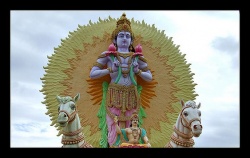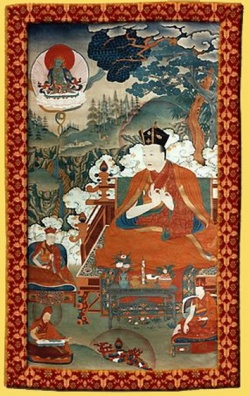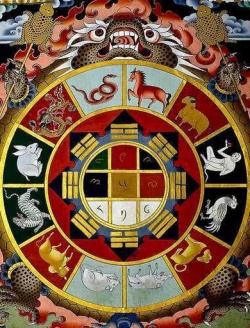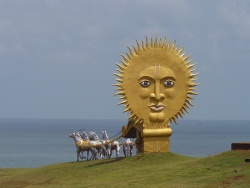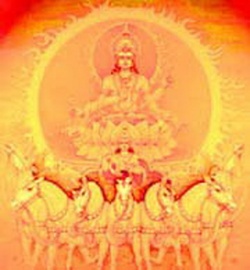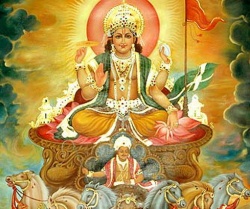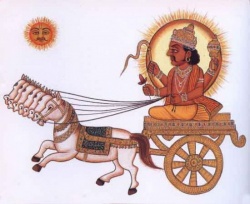Difference between revisions of "Surya (Hinduism)"
| Line 1: | Line 1: | ||
[[File:7d755.jpg|thumb|250px|]] | [[File:7d755.jpg|thumb|250px|]] | ||
<poem> | <poem> | ||
| − | [[Surya]] ({{Wiki|Devanagari}}: सूर्य [[Sūrya]], "the [[Supreme]] [[ | + | [[Surya]] ({{Wiki|Devanagari}}: सूर्य [[Sūrya]], "the [[Supreme Light]]") [[Suraya]] or [[Phra Athit]] is the chief {{Wiki|solar}} [[deity]] in [[Hinduism]]. The term [[Surya]] also refers to the {{Wiki|Sun}}, in general. |
[[File:7karmapa.jpeg|thumb|250px|]] | [[File:7karmapa.jpeg|thumb|250px|]] | ||
| − | [[Surya]] is the chief of the [[Navagraha]], [[Indian]] "Classical {{Wiki|planets}}" and important [[elements]] of [[Hindu]] [[Astrology]]. He is often depicted riding a [[chariot]] harnessed by seven [[horses]] or one [[horse]] with seven heads, which represent the seven colours of the [[rainbow]] or the seven [[chakras]]. He also presides over Sunday. [[Surya]] is regarded as the [[Supreme]] [[Deity]] by [[Saura]] [[sect]], which is now a very small following. {{Wiki|Smartas}} {{Wiki|worship}} him as one of the five [[primary]] [[forms]] of [[God]]. | + | [[Surya]] is the chief of the [[Navagraha]], [[Indian]] "Classical {{Wiki|planets}}" and important [[elements]] of [[Hindu]] [[Astrology]]. He is often depicted riding a [[chariot]] harnessed by seven [[horses]] or one [[horse]] with seven heads, which represent the seven colours of the [[rainbow]] or the seven [[chakras]]. |
| + | |||
| + | He also presides over Sunday. [[Surya]] is regarded as the [[Supreme]] [[Deity]] by [[Saura]] [[sect]], which is now a very small following. | ||
| + | |||
| + | {{Wiki|Smartas}} {{Wiki|worship}} him as one of the five [[primary]] [[forms]] of [[God]]. | ||
[[File:476422 n.jpg|thumb|250px|]] | [[File:476422 n.jpg|thumb|250px|]] | ||
[[Surya]] as the {{Wiki|Sun}} is worshipped at dawn by most [[Hindus]] and has many [[temples]] dedicated to him across [[India]]. He also enjoys {{Wiki|worship}} as a part of the [[Navagraha]]. He is especially worshipped in the [[Hindu]] {{Wiki|festivals}} of [[Ratha]] Saptami, Makar Sankranti, Chhath and Samba Dashami. | [[Surya]] as the {{Wiki|Sun}} is worshipped at dawn by most [[Hindus]] and has many [[temples]] dedicated to him across [[India]]. He also enjoys {{Wiki|worship}} as a part of the [[Navagraha]]. He is especially worshipped in the [[Hindu]] {{Wiki|festivals}} of [[Ratha]] Saptami, Makar Sankranti, Chhath and Samba Dashami. | ||
| Line 12: | Line 16: | ||
Arka [[Form]] | Arka [[Form]] | ||
| − | [[Surya]] is worshiped in various [[forms]] throughout [[India]]. One of the most important [[Epithet]] ([[Form]]) of '[[Surya]]' is 'Arka'. The "Arka" [[Form]] is worshiped mostly in {{Wiki|North}} [[India]] and Eastern parts of [[India]]. The [[temples]] dedicated to 'Arka' [[Form]] of [[Surya]] are Konarka [[Temple]] in {{Wiki|Orissa}}, Uttararka and Lolarka in {{Wiki|Uttar Pradesh}}, Balarka in {{Wiki|Rajasthan}}. There was an old sun-temple in (Bahraich, {{Wiki|Uttar Pradesh}}) named | + | [[Surya]] is worshiped in various [[forms]] throughout [[India]]. One of the most important [[Epithet]] ([[Form]]) of '[[Surya]]' is 'Arka'. The "Arka" [[Form]] is worshiped mostly in {{Wiki|North}} [[India]] and Eastern parts of [[India]]. The [[temples]] dedicated to 'Arka' [[Form]] of [[Surya]] are Konarka [[Temple]] in {{Wiki|Orissa}}, [[Uttararka]] and [[Lolarka]] in {{Wiki|Uttar Pradesh}}, Balarka in {{Wiki|Rajasthan}}. There was an old sun-temple in (Bahraich, {{Wiki|Uttar Pradesh}}) named [[Balarka Surya Mandir]], built by [[King]] [[Tilokchand Arkawanshi]] in early 10th century AD. The [[temple]] was destroyed in the 14th century during {{Wiki|Turkish}} invasions. |
The {{Wiki|Sun}} [[Temple]], Modhera, at Modhera in {{Wiki|Gujarat}}, is a [[temple]] dedicated to the [[Hindu]] {{Wiki|Sun}}-[[God]], [[Surya]]. It was built in 1026 AD by [[King]] Bhimdev of the Solanki {{Wiki|dynasty}}. | The {{Wiki|Sun}} [[Temple]], Modhera, at Modhera in {{Wiki|Gujarat}}, is a [[temple]] dedicated to the [[Hindu]] {{Wiki|Sun}}-[[God]], [[Surya]]. It was built in 1026 AD by [[King]] Bhimdev of the Solanki {{Wiki|dynasty}}. | ||
| Line 18: | Line 22: | ||
'[[Surya]]' is also known as '[[Mitra]]' ([[meaning]] [[friend]]) for his [[Life]] nourishing properties. [[Mitra]] [[Form]] of '[[Surya]]' had been worshiped mostly in {{Wiki|Gujarat}}, where a {{Wiki|clan}} of Suryawanshi {{Wiki|kings}} was known as Mitrawanshi {{Wiki|kshatriyas}}, also known by its distorted [[name]] Maitrakas (मैत्रक) | '[[Surya]]' is also known as '[[Mitra]]' ([[meaning]] [[friend]]) for his [[Life]] nourishing properties. [[Mitra]] [[Form]] of '[[Surya]]' had been worshiped mostly in {{Wiki|Gujarat}}, where a {{Wiki|clan}} of Suryawanshi {{Wiki|kings}} was known as Mitrawanshi {{Wiki|kshatriyas}}, also known by its distorted [[name]] Maitrakas (मैत्रक) | ||
| + | |||
[[Religious]] role and relationships | [[Religious]] role and relationships | ||
[[File:Surya_65a0df4.jpg|thumb|250px|]] | [[File:Surya_65a0df4.jpg|thumb|250px|]] | ||
| − | Vivasvata ([[Surya]], {{Wiki|Osiris}}, Sirius, Sothis) had three queens; Saranyu (also called Saraniya, {{Wiki|Saranya}}, [[Sanjna]], or [[Sangya]]) (the Orion Belt), Ragyi, and [[Prabha]]. Saranyu was the mother of [[Vaivasvata | + | Vivasvata ([[Surya]], {{Wiki|Osiris}}, Sirius, Sothis) had three queens; [[Saranyu]] (also called [[Saraniya]], {{Wiki|Saranya}}, [[Sanjna]], or [[Sangya]]) (the Orion Belt), Ragyi, and [[Prabha]]. Saranyu was the mother of [[Vaivasvata Manu]] or [[Sraddhadeva Manu]] (the seventh, i.e. {{Wiki|present}} [[Manu]]) and the twins [[Yama]] (the [[Lord]] of [[Death]]) and his sister [[Wikipedia:Yamuna in Hinduism|Yami]]. She also bore him the twins known as the {{Wiki|Ashvins}}, [[divine]] horsemen and physicians to the [[Devas]]. Saranyu, [[being]] unable to bear the extreme radiance of [[Surya]], created a [[superficial]] {{Wiki|entity}} from her shadow called Chhaya and instructed her to act as [[Surya's]] wife in her absence. [[Chhaya]] mothered two sons – [[Savarni Manu]] (the eighth, i.e. next [[Manu]]) and {{Wiki|Shani}} (the {{Wiki|planet}} {{Wiki|Saturn}}), and two daughters – [[Tapti]] and [[Vishti]]. He also has a son, {{Wiki|Revanta}}, or [[Raivata]], by [[Ragyi]]. |
Interestingly, [[Surya's]] two sons {{Wiki|Shani}} and [[Yama]] (Pollux and Castor) are responsible for the [[judgment]] of [[human]] [[Life]]. {{Wiki|Shani}} gives us the results of one's [[deeds]] through one's [[Life]] through [[appropriate]] punishments and rewards while [[Yama]] grants the results of one's [[deeds]] after [[Death]]. | Interestingly, [[Surya's]] two sons {{Wiki|Shani}} and [[Yama]] (Pollux and Castor) are responsible for the [[judgment]] of [[human]] [[Life]]. {{Wiki|Shani}} gives us the results of one's [[deeds]] through one's [[Life]] through [[appropriate]] punishments and rewards while [[Yama]] grants the results of one's [[deeds]] after [[Death]]. | ||
| − | In {{Wiki|Ramayana}}, [[Surya]] is described as father of the [[King]] Sugriva, who helped {{Wiki|Rama}} and {{Wiki|Lakshmana}} in defeating the [[demon]] [[king]] {{Wiki|Ravana}}. He also trains [[Hanuman]] as his [[Guru]]. The Suryavanshi / [[Suryavansha]] {{Wiki|dynasty}} of {{Wiki|kings}}, {{Wiki|Rama}} [[being]] one of them, also claims descent from [[Surya]]. | + | In {{Wiki|Ramayana}}, [[Surya]] is described as father of the [[King]] [[Sugriva]], who helped {{Wiki|Rama}} and {{Wiki|Lakshmana}} in defeating the [[demon]] [[king]] {{Wiki|Ravana}}. He also trains [[Hanuman]] as his [[Guru]]. The [[Suryavanshi]] / [[Suryavansha]] {{Wiki|dynasty}} of {{Wiki|kings}}, {{Wiki|Rama}} [[being]] one of them, also claims descent from [[Surya]]. |
| + | |||
| + | In the {{Wiki|Mahabharata}}, {{Wiki|Princess}} [[Kunti]] receives instruction for a [[Mantra]] from the [[sage]] [[Durvasa]]; by reciting which, she would be able to summon any [[God]] and bear a child by him. Incredulous of the [[Power]] of this [[Mantra]], [[Kunti]] unwittingly tests it on [[Surya]], but when [[Surya]] appears, she gets scared and requests him to go back. However, [[Surya]] has an {{Wiki|obligation}} to fulfill the [[Mantra]] before returning. [[Surya]] miraculously [[causes]] [[Kunti]] to bear the child immediately whilst retaining her [[virginity]] so that she, as an unmarried {{Wiki|princess}}, need not face any {{Wiki|embarrassment}} or be subjected to questions from {{Wiki|society}}. [[Kunti]] [[feels]] compelled to abandon the child, {{Wiki|Karna}}, who grows up to become one of the {{Wiki|central}} characters in the great {{Wiki|battle}} of [[Wikipedia:Kurukshetra War|Kurukshetra]]. | ||
| − | |||
In {{Wiki|Zoroastrianism}} | In {{Wiki|Zoroastrianism}} | ||
In the [[Vedas]], [[Surya]] is frequently referred to as "the [[eye]] of [[Mitra]], {{Wiki|Varuna]], and [[Agni]]" (RV 1.115.1, RV 6.51.1, RV 7.63.1, WYV 4.35, WYV 7.42, WYV 13.46, AV 13.2.35). This bears striking similarities to Zoroastrian [[scriptures]], where the {{Wiki|Sun}} is described as "the [[eye]] of [[Ahura Mazda]]". | In the [[Vedas]], [[Surya]] is frequently referred to as "the [[eye]] of [[Mitra]], {{Wiki|Varuna]], and [[Agni]]" (RV 1.115.1, RV 6.51.1, RV 7.63.1, WYV 4.35, WYV 7.42, WYV 13.46, AV 13.2.35). This bears striking similarities to Zoroastrian [[scriptures]], where the {{Wiki|Sun}} is described as "the [[eye]] of [[Ahura Mazda]]". | ||
| + | |||
In [[Astrology]] | In [[Astrology]] | ||
[[File:God-sun.jpg|thumb|250px|]] | [[File:God-sun.jpg|thumb|250px|]] | ||
| − | In {{Wiki|Vedic}} [[Astrology]] [[Surya]] is considered a mild malefic on account of his [[hot]], dry [[nature]]. [[Surya]] represents [[soul]], will-[[Power]], [[Fame]], the [[eyes]], general [[vitality]], {{Wiki|courage}}, [[kingship]], father, highly placed persons and authority. He is [[exalted]] in the sign Mesha(Aries) and is in {{Wiki|decline}} in the sign [[Tula]] ([[Libra]]). The strongest placement for [[Surya]] is directly overhead in the 10th house, and on the angles (the 1st, 5th and 9th houses). [[Surya]] is [[Lord]] of three [[nakshatras]] or [[lunar mansions]]: [[Krittika]], [[Uttara]] | + | In {{Wiki|Vedic}} [[Astrology]] [[Surya]] is considered a mild malefic on account of his [[hot]], dry [[nature]]. [[Surya]] represents [[soul]], will-[[Power]], [[Fame]], the [[eyes]], general [[vitality]], {{Wiki|courage}}, [[kingship]], father, highly placed persons and authority. He is [[exalted]] in the sign [[Mesha]]([[Aries]]) and is in {{Wiki|decline}} in the sign [[Tula]] ([[Libra]]). The strongest placement for [[Surya]] is directly overhead in the 10th house, and on the angles (the 1st, 5th and 9th houses). [[Surya]] is [[Lord]] of three [[nakshatras]] or [[lunar mansions]]: [[Krittika]], [[Uttara Phalguni]] and [[Uttara Ashadha]]. [[Surya]] has the following associations: the colors – {{Wiki|copper}} or red, the metals – {{Wiki|gold}} or brass, the gemstone – {{Wiki|ruby}}, the [[direction]] – {{Wiki|east}} and the season of summer. The [[Food]] grain associated with him (one of [[Nava Dhanyas]]) is {{Wiki|wheat}}. |
Strong and well placed {{Wiki|Sun}} in the [[birth]] chart makes a [[person]] [[Noble]], determined and genial. [[People]] governed by well disposed {{Wiki|Sun}} are honest, trustworthy and loyal. They do not like to be dominated and they can be extremely difficult if they are cheated or lied to. [[People]] ruled by the {{Wiki|Sun}} easily assume fatherly role and lead the team as per their notions and whim. As a result, they are not appreciated most of the [[time]]. Afflicted {{Wiki|sun}} in the [[birth]] chart makes a [[person]] [[arrogant]] and stubborn. [[People]] with malefic {{Wiki|Sun}} have exaggerated [[ego]] and they enjoy creating trouble for other [[people]]. The latent potential bestowed by the {{Wiki|Sun}} needs to be channelized in right [[direction]] to prevent them from heading on the wrong [[path]]. | Strong and well placed {{Wiki|Sun}} in the [[birth]] chart makes a [[person]] [[Noble]], determined and genial. [[People]] governed by well disposed {{Wiki|Sun}} are honest, trustworthy and loyal. They do not like to be dominated and they can be extremely difficult if they are cheated or lied to. [[People]] ruled by the {{Wiki|Sun}} easily assume fatherly role and lead the team as per their notions and whim. As a result, they are not appreciated most of the [[time]]. Afflicted {{Wiki|sun}} in the [[birth]] chart makes a [[person]] [[arrogant]] and stubborn. [[People]] with malefic {{Wiki|Sun}} have exaggerated [[ego]] and they enjoy creating trouble for other [[people]]. The latent potential bestowed by the {{Wiki|Sun}} needs to be channelized in right [[direction]] to prevent them from heading on the wrong [[path]]. | ||
{{Wiki|Sun}} [[Temples]] | {{Wiki|Sun}} [[Temples]] | ||
| − | There are [[Surya]] [[temples]] all across [[India]]. The most famous is the [[World]] Heritage Site of the {{Wiki|Sun}} [[Temple]], Konark, {{Wiki|Orissa}}. Besides Konark, there are two other {{Wiki|sun}} [[temples]] in {{Wiki|Orissa}} called | + | There are [[Surya]] [[temples]] all across [[India]]. The most famous is the [[World]] Heritage Site of the {{Wiki|Sun}} [[Temple]], Konark, {{Wiki|Orissa}}. Besides Konark, there are two other {{Wiki|sun}} [[temples]] in {{Wiki|Orissa}} called [[Biranchi Narayan]] {{Wiki|Sun}} [[Temple]] in Buguda, Ganjam District and [[Biranchinarayan Temple]], [[Palia]], [[Bhadrak]]. |
There are {{Wiki|sun}} [[temples]] in Modhera, {{Wiki|Gujarat}}, created by [[King]] Bhimdev of the Solanki {{Wiki|dynasty}}, in Arasavalli, [[Andhra Pradesh]], Kanakaditya [[Temple]] in Kasheli (Dist. Sindhudurg) – [[Maharashtra]], near the famous Galtaji's [[temple]] in [[Jaipur]], {{Wiki|Rajasthan}} and in [[clusters]] of {{Wiki|Navagraha temples}} in [[Tamil Nadu]] and {{Wiki|Assam}}. The {{Wiki|Sun}} [[Temple]] at Martand in [[Jammu]] and [[Kashmir]] and {{Wiki|Sun}} [[Temple]] of [[Multan]] are [[temples]] which were destroyed. The only and the famous [[Surya]] [[temple]] in northern [[India]] is Kattarmal [[surya]] mandir in {{Wiki|Almora}} District, [[Uttarakhand]] created by [[King]] Kattarmal in the 12th century. | There are {{Wiki|sun}} [[temples]] in Modhera, {{Wiki|Gujarat}}, created by [[King]] Bhimdev of the Solanki {{Wiki|dynasty}}, in Arasavalli, [[Andhra Pradesh]], Kanakaditya [[Temple]] in Kasheli (Dist. Sindhudurg) – [[Maharashtra]], near the famous Galtaji's [[temple]] in [[Jaipur]], {{Wiki|Rajasthan}} and in [[clusters]] of {{Wiki|Navagraha temples}} in [[Tamil Nadu]] and {{Wiki|Assam}}. The {{Wiki|Sun}} [[Temple]] at Martand in [[Jammu]] and [[Kashmir]] and {{Wiki|Sun}} [[Temple]] of [[Multan]] are [[temples]] which were destroyed. The only and the famous [[Surya]] [[temple]] in northern [[India]] is Kattarmal [[surya]] mandir in {{Wiki|Almora}} District, [[Uttarakhand]] created by [[King]] Kattarmal in the 12th century. | ||
[[File:Surya-hindu-god.jpg|thumb|250px|]] | [[File:Surya-hindu-god.jpg|thumb|250px|]] | ||
| − | The Gurjars were [[essentially]] {{Wiki|sun}} worshipers and some of the {{Wiki|sun}} [[temples]] were erected by them during the {{Wiki|medieval}} period. The {{Wiki|sun}} [[temple]] known as Jayaditya was [[constructed]] by Gurjar [[king]] of Nandipuri, Jayabhatta II.This [[temple]] is situated at Kotipura near Kapika in the Bharukachha district. The [[Surya]] [[temple]] of Bhinmal known as | + | The Gurjars were [[essentially]] {{Wiki|sun}} worshipers and some of the {{Wiki|sun}} [[temples]] were erected by them during the {{Wiki|medieval}} period. The {{Wiki|sun}} [[temple]] known as [[Jayaditya]] was [[constructed]] by Gurjar [[king]] of Nandipuri, Jayabhatta II.This [[temple]] is situated at Kotipura near Kapika in the Bharukachha district. The [[Surya]] [[temple]] of Bhinmal known as [[Jagaswami Surya temple]] was also erected during this period. |
{{Wiki|Festivals}} | {{Wiki|Festivals}} | ||
| Line 48: | Line 55: | ||
There are Various {{Wiki|Festivals}} dedicated to {{Wiki|Sun}} [[God]] [[Surya]] in [[India]]. | There are Various {{Wiki|Festivals}} dedicated to {{Wiki|Sun}} [[God]] [[Surya]] in [[India]]. | ||
| − | [[Makara]] | + | [[Makara Sankaranti]] is most Widely celebrated [[Hindu]] {{Wiki|festival}} dedicated to the {{Wiki|Sun}} [[God]]. It is celebrated as [[Makara Sankranti]] throughout [[India]] and as Pongal by [[Tamils]] all over the [[World]]. [[People]] thank the {{Wiki|Sun}} [[God]] for ensuring a good harvest and dedicate the first grain to him. |
| − | Chhath is another [[Hindu]] {{Wiki|Festival}} dedicated to [[Surya]]. It is believed to started by {{Wiki|Karna}}, the son of [[Surya]], who became a great [[warrior]] and fought against the {{Wiki|Pandavas}} in the [[Wikipedia:Kurukshetra War|Kurukshetra]] [[War]]. Chhath is unique to {{Wiki|Bihar}}, [[Jharkhand]] and the some Parts of {{Wiki|Uttar Pradesh}}, [[Nepal]] & Mauritius. | + | [[Chhath]] is another [[Hindu]] {{Wiki|Festival}} dedicated to [[Surya]]. It is believed to started by {{Wiki|Karna}}, the son of [[Surya]], who became a great [[warrior]] and fought against the {{Wiki|Pandavas}} in the [[Wikipedia:Kurukshetra War|Kurukshetra]] [[War]]. Chhath is unique to {{Wiki|Bihar}}, [[Jharkhand]] and the some Parts of {{Wiki|Uttar Pradesh}}, [[Nepal]] & Mauritius. |
Samba Dashami is another {{Wiki|festival}} celebrated in the eastern coastal [[state]] of {{Wiki|Orissa}}, [[India]] in the honour of Samba, the son of {{Wiki|Krishna}} who got cured from {{Wiki|leprosy}} by praying to [[Surya]]. | Samba Dashami is another {{Wiki|festival}} celebrated in the eastern coastal [[state]] of {{Wiki|Orissa}}, [[India]] in the honour of Samba, the son of {{Wiki|Krishna}} who got cured from {{Wiki|leprosy}} by praying to [[Surya]]. | ||
| − | [[Ratha]] | + | [[Ratha Saptami]] is a [[Hindu]] {{Wiki|festival}} that falls on the Seventh day ([[Saptami]]) of the bright half of the [[Hindu]] month Maagha. |
| + | |||
| + | This day is also known as [[Surya Jayanti]] because it celebrates the [[Power]] of the {{Wiki|Sun}} [[God]] who is believed to be an [[incarnation]] of [[Lord]] [[Vishnu]]. [[Lord]] [[Vishnu]] in his [[Form]] as [[Surya]] is usually worshiped on this day. Usually, [[Rathasapthami]] begins in households with a [[Purification]] bath by [[holding]] a few calotropis leaves on one's {{Wiki|head}} and shoulders while bathing and [[Chanting]] a verse which is supposed to invoke the [[benevolence]] of the [[Lord]] in all that one takes up the rest of the year. It also involves doing a [[Puja]] with the [[ritual]] '[[Naivedyam]]', [[Flowers]] and [[fruits]]. On this day at [[Tirumala]] ([[Andhra Pradesh]]), [[Lord]] [[Venkateshwara (Balaji]]) is mounted on [[Seven Vahanas]] ([[Celestial]] Vehicles) one after the other starting from [[Suryaprabha]] [[Vahana]] and ending with [[Chandraprabha Vahana]]. Other Vahanas are [[Hanumad vahana]], [[Garuda Vahana]], [[Peddashesha Vahana]], [[Kalpavruksha vahana]] and [[Sarvabhupala vahana]]. Also [[chakrasnanam]] is performed on the same day. A [[devotee]] enjoys watching the [[Lord]] mounted on different [[vahanas]] in one day which is popularly known as [[Okka roju Brahmotsavam]] (Single day {{Wiki|celebrations}}]]). | ||
| + | |||
In {{Wiki|Mahabharata}} | In {{Wiki|Mahabharata}} | ||
| + | |||
[[File:Surya408_o3.jpg|thumb|250px|]] | [[File:Surya408_o3.jpg|thumb|250px|]] | ||
| − | [[Surya]] is not mentioned as one of the [[Adityas]] in the first [[book]] of the {{Wiki|epic}} Mahabarata, but may be regarded as the [[compound]] of the twelve {{Wiki|solar}} [[deities]] mentioned there, to be understood in connection to the [[Jyotisha]] {{Wiki|vedic}} [[Astrology]]: Dhatri, [[Mitra]], [[Aryaman]], [[Sakra]], {{Wiki|Varuna]], [[Amsa]], Vaga, Vivaswat, Usha, [[Savitri]], Tvashtri, [[Vishnu]]. | + | [[Surya]] is not mentioned as one of the [[Adityas]] in the first [[book]] of the {{Wiki|epic}} [[Mahabarata]], but may be regarded as the [[compound]] of the twelve {{Wiki|solar}} [[deities]] mentioned there, to be understood in connection to the [[Jyotisha]] {{Wiki|vedic}} [[Astrology]]: [[Dhatri]], [[Mitra]], [[Aryaman]], [[Sakra]], {{Wiki|Varuna]], [[Amsa]], [[Vaga]], [[Vivaswat]], [[Usha]], [[Savitri]], [[Tvashtri]], [[Vishnu]]. |
In {{Wiki|Mahabharata}}, [[Surya]] is referred to as father of {{Wiki|Karna}}, as he begot the [[latter]] on [[Kunti]] when she was virgin. With his grace and in [[order]] that [[Kunti]] is not spoken of badly in the [[World]], [[Kunti]] could retain virginhood even after delivering a child. | In {{Wiki|Mahabharata}}, [[Surya]] is referred to as father of {{Wiki|Karna}}, as he begot the [[latter]] on [[Kunti]] when she was virgin. With his grace and in [[order]] that [[Kunti]] is not spoken of badly in the [[World]], [[Kunti]] could retain virginhood even after delivering a child. | ||
| − | [[Saurashtra]] | + | |
| + | |||
| + | [[Saurashtra Surymandir]] | ||
The Kathi Darbar, [[Shri]] Amra Patgir developed the [[temple]] of [[Shri]] Surynarayan in Thangadh village of Surendranagar district in {{Wiki|Gujarat}}. The kathis were come in [[Saurashtra]] in the 12th and 13th centuries. | The Kathi Darbar, [[Shri]] Amra Patgir developed the [[temple]] of [[Shri]] Surynarayan in Thangadh village of Surendranagar district in {{Wiki|Gujarat}}. The kathis were come in [[Saurashtra]] in the 12th and 13th centuries. | ||
[[Surya]] [[namaskara]], or the "{{Wiki|Sun}} salutation" | [[Surya]] [[namaskara]], or the "{{Wiki|Sun}} salutation" | ||
| − | A well-known [[Hindu]] mode of {{Wiki|worship}} of the devotional movements of [[Surya]] is done at the rising of the {{Wiki|Sun}}, known as [[Sūrya]] | + | A well-known [[Hindu]] mode of {{Wiki|worship}} of the devotional movements of [[Surya]] is done at the rising of the {{Wiki|Sun}}, known as [[Sūrya namaskāra]] ({{Wiki|sun}} salutation). Ten [[yogic]] [[postures]] are assumed in successive flowing movements to complete one [[namaskar]]. Twelve [[sacred]] [[Hindu]] [[mantras]] uttered and for each [[Mantra]] one complete [[namaskar]] is done. {{Wiki|Ancient}} practice is to do [[108]] namaskaras a day. It is considered most [[auspicious]] by [[Hindus]] to do this. |
The 12 [[mantras]] for [[surya]] [[namaskara]]: | The 12 [[mantras]] for [[surya]] [[namaskara]]: | ||
| Line 88: | Line 101: | ||
Throughout the dusky {{Wiki|firmament}} advancing, laying to rest the [[immortal]] and the {{Wiki|mortal}}, | Throughout the dusky {{Wiki|firmament}} advancing, laying to rest the [[immortal]] and the {{Wiki|mortal}}, | ||
| − | Borne in his golden [[chariot]] he cometh, Savitar, [[God]] who looks on every creature. | + | Borne in his golden [[chariot]] he cometh, [[Savitar]], [[God]] who looks on every creature. |
| − | The [[Gayatri | + | The [[Gayatri Mantra]] is also associated with [[Surya]]. Another hymn associated with [[Surya]] is the [[Aditya Hridayam]], recited by the great [[sage]] [[Agastya]] to {{Wiki|Rama}} on the warfield before the fight with {{Wiki|Ravana}}. |
</poem> | </poem> | ||
{{W}} | {{W}} | ||
Latest revision as of 03:16, 21 September 2015
Surya (Devanagari: सूर्य Sūrya, "the Supreme Light") Suraya or Phra Athit is the chief solar deity in Hinduism. The term Surya also refers to the Sun, in general.
Surya is the chief of the Navagraha, Indian "Classical planets" and important elements of Hindu Astrology. He is often depicted riding a chariot harnessed by seven horses or one horse with seven heads, which represent the seven colours of the rainbow or the seven chakras.
He also presides over Sunday. Surya is regarded as the Supreme Deity by Saura sect, which is now a very small following.
Smartas worship him as one of the five primary forms of God.
Surya as the Sun is worshipped at dawn by most Hindus and has many temples dedicated to him across India. He also enjoys worship as a part of the Navagraha. He is especially worshipped in the Hindu festivals of Ratha Saptami, Makar Sankranti, Chhath and Samba Dashami.
Depictions
Sometimes, Surya is depicted with two hands holding a Lotus in both; sometimes he has four hands holding a Lotus, chakra, a Conch, and a mace.
Arka Form
Surya is worshiped in various forms throughout India. One of the most important Epithet (Form) of 'Surya' is 'Arka'. The "Arka" Form is worshiped mostly in North India and Eastern parts of India. The temples dedicated to 'Arka' Form of Surya are Konarka Temple in Orissa, Uttararka and Lolarka in Uttar Pradesh, Balarka in Rajasthan. There was an old sun-temple in (Bahraich, Uttar Pradesh) named Balarka Surya Mandir, built by King Tilokchand Arkawanshi in early 10th century AD. The temple was destroyed in the 14th century during Turkish invasions.
The Sun Temple, Modhera, at Modhera in Gujarat, is a temple dedicated to the Hindu Sun-God, Surya. It was built in 1026 AD by King Bhimdev of the Solanki dynasty.
'Mitra' Form of Surya
'Surya' is also known as 'Mitra' (meaning friend) for his Life nourishing properties. Mitra Form of 'Surya' had been worshiped mostly in Gujarat, where a clan of Suryawanshi kings was known as Mitrawanshi kshatriyas, also known by its distorted name Maitrakas (मैत्रक)
Religious role and relationships
Vivasvata (Surya, Osiris, Sirius, Sothis) had three queens; Saranyu (also called Saraniya, Saranya, Sanjna, or Sangya) (the Orion Belt), Ragyi, and Prabha. Saranyu was the mother of Vaivasvata Manu or Sraddhadeva Manu (the seventh, i.e. present Manu) and the twins Yama (the Lord of Death) and his sister Yami. She also bore him the twins known as the Ashvins, divine horsemen and physicians to the Devas. Saranyu, being unable to bear the extreme radiance of Surya, created a superficial entity from her shadow called Chhaya and instructed her to act as Surya's wife in her absence. Chhaya mothered two sons – Savarni Manu (the eighth, i.e. next Manu) and Shani (the planet Saturn), and two daughters – Tapti and Vishti. He also has a son, Revanta, or Raivata, by Ragyi.
Interestingly, Surya's two sons Shani and Yama (Pollux and Castor) are responsible for the judgment of human Life. Shani gives us the results of one's deeds through one's Life through appropriate punishments and rewards while Yama grants the results of one's deeds after Death.
In Ramayana, Surya is described as father of the King Sugriva, who helped Rama and Lakshmana in defeating the demon king Ravana. He also trains Hanuman as his Guru. The Suryavanshi / Suryavansha dynasty of kings, Rama being one of them, also claims descent from Surya.
In the Mahabharata, Princess Kunti receives instruction for a Mantra from the sage Durvasa; by reciting which, she would be able to summon any God and bear a child by him. Incredulous of the Power of this Mantra, Kunti unwittingly tests it on Surya, but when Surya appears, she gets scared and requests him to go back. However, Surya has an obligation to fulfill the Mantra before returning. Surya miraculously causes Kunti to bear the child immediately whilst retaining her virginity so that she, as an unmarried princess, need not face any embarrassment or be subjected to questions from society. Kunti feels compelled to abandon the child, Karna, who grows up to become one of the central characters in the great battle of Kurukshetra.
In Zoroastrianism
In the Vedas, Surya is frequently referred to as "the eye of Mitra, {{Wiki|Varuna]], and Agni" (RV 1.115.1, RV 6.51.1, RV 7.63.1, WYV 4.35, WYV 7.42, WYV 13.46, AV 13.2.35). This bears striking similarities to Zoroastrian scriptures, where the Sun is described as "the eye of Ahura Mazda".
In Astrology
In Vedic Astrology Surya is considered a mild malefic on account of his hot, dry nature. Surya represents soul, will-Power, Fame, the eyes, general vitality, courage, kingship, father, highly placed persons and authority. He is exalted in the sign Mesha(Aries) and is in decline in the sign Tula (Libra). The strongest placement for Surya is directly overhead in the 10th house, and on the angles (the 1st, 5th and 9th houses). Surya is Lord of three nakshatras or lunar mansions: Krittika, Uttara Phalguni and Uttara Ashadha. Surya has the following associations: the colors – copper or red, the metals – gold or brass, the gemstone – ruby, the direction – east and the season of summer. The Food grain associated with him (one of Nava Dhanyas) is wheat.
Strong and well placed Sun in the birth chart makes a person Noble, determined and genial. People governed by well disposed Sun are honest, trustworthy and loyal. They do not like to be dominated and they can be extremely difficult if they are cheated or lied to. People ruled by the Sun easily assume fatherly role and lead the team as per their notions and whim. As a result, they are not appreciated most of the time. Afflicted sun in the birth chart makes a person arrogant and stubborn. People with malefic Sun have exaggerated ego and they enjoy creating trouble for other people. The latent potential bestowed by the Sun needs to be channelized in right direction to prevent them from heading on the wrong path.
Sun Temples
There are Surya temples all across India. The most famous is the World Heritage Site of the Sun Temple, Konark, Orissa. Besides Konark, there are two other sun temples in Orissa called Biranchi Narayan Sun Temple in Buguda, Ganjam District and Biranchinarayan Temple, Palia, Bhadrak.
There are sun temples in Modhera, Gujarat, created by King Bhimdev of the Solanki dynasty, in Arasavalli, Andhra Pradesh, Kanakaditya Temple in Kasheli (Dist. Sindhudurg) – Maharashtra, near the famous Galtaji's temple in Jaipur, Rajasthan and in clusters of Navagraha temples in Tamil Nadu and Assam. The Sun Temple at Martand in Jammu and Kashmir and Sun Temple of Multan are temples which were destroyed. The only and the famous Surya temple in northern India is Kattarmal surya mandir in Almora District, Uttarakhand created by King Kattarmal in the 12th century.
The Gurjars were essentially sun worshipers and some of the sun temples were erected by them during the medieval period. The sun temple known as Jayaditya was constructed by Gurjar king of Nandipuri, Jayabhatta II.This temple is situated at Kotipura near Kapika in the Bharukachha district. The Surya temple of Bhinmal known as Jagaswami Surya temple was also erected during this period.
Festivals
There are Various Festivals dedicated to Sun God Surya in India.
Makara Sankaranti is most Widely celebrated Hindu festival dedicated to the Sun God. It is celebrated as Makara Sankranti throughout India and as Pongal by Tamils all over the World. People thank the Sun God for ensuring a good harvest and dedicate the first grain to him.
Chhath is another Hindu Festival dedicated to Surya. It is believed to started by Karna, the son of Surya, who became a great warrior and fought against the Pandavas in the Kurukshetra War. Chhath is unique to Bihar, Jharkhand and the some Parts of Uttar Pradesh, Nepal & Mauritius.
Samba Dashami is another festival celebrated in the eastern coastal state of Orissa, India in the honour of Samba, the son of Krishna who got cured from leprosy by praying to Surya.
Ratha Saptami is a Hindu festival that falls on the Seventh day (Saptami) of the bright half of the Hindu month Maagha.
This day is also known as Surya Jayanti because it celebrates the Power of the Sun God who is believed to be an incarnation of Lord Vishnu. Lord Vishnu in his Form as Surya is usually worshiped on this day. Usually, Rathasapthami begins in households with a Purification bath by holding a few calotropis leaves on one's head and shoulders while bathing and Chanting a verse which is supposed to invoke the benevolence of the Lord in all that one takes up the rest of the year. It also involves doing a Puja with the ritual 'Naivedyam', Flowers and fruits. On this day at Tirumala (Andhra Pradesh), Lord Venkateshwara (Balaji) is mounted on Seven Vahanas (Celestial Vehicles) one after the other starting from Suryaprabha Vahana and ending with Chandraprabha Vahana. Other Vahanas are Hanumad vahana, Garuda Vahana, Peddashesha Vahana, Kalpavruksha vahana and Sarvabhupala vahana. Also chakrasnanam is performed on the same day. A devotee enjoys watching the Lord mounted on different vahanas in one day which is popularly known as Okka roju Brahmotsavam (Single day celebrations]]).
In Mahabharata
Surya is not mentioned as one of the Adityas in the first book of the epic Mahabarata, but may be regarded as the compound of the twelve solar deities mentioned there, to be understood in connection to the Jyotisha vedic Astrology: Dhatri, Mitra, Aryaman, Sakra, {{Wiki|Varuna]], Amsa, Vaga, Vivaswat, Usha, Savitri, Tvashtri, Vishnu.
In Mahabharata, Surya is referred to as father of Karna, as he begot the latter on Kunti when she was virgin. With his grace and in order that Kunti is not spoken of badly in the World, Kunti could retain virginhood even after delivering a child.
Saurashtra Surymandir
The Kathi Darbar, Shri Amra Patgir developed the temple of Shri Surynarayan in Thangadh village of Surendranagar district in Gujarat. The kathis were come in Saurashtra in the 12th and 13th centuries.
Surya namaskara, or the "Sun salutation"
A well-known Hindu mode of worship of the devotional movements of Surya is done at the rising of the Sun, known as Sūrya namaskāra (sun salutation). Ten yogic postures are assumed in successive flowing movements to complete one namaskar. Twelve sacred Hindu mantras uttered and for each Mantra one complete namaskar is done. Ancient practice is to do 108 namaskaras a day. It is considered most auspicious by Hindus to do this.
The 12 mantras for surya namaskara:
ॐ मित्राय नमः aum mitrāya namah
ॐ रवये नमः aum ravayé namah
ॐ सूर्याय नमः aum sūryāya namah
ॐ भानवे नमः aum bhānavé namah
ॐ खगाय नमः aum khagāya namah
ॐ पुष्णे नमः aum pushné namah
ॐ हिरण्यगर्भाय नमः aum hiranyagarbhāya namah
ॐ मारिचाये नमः aum mārichāyé namah
ॐ आदित्याय नमः aum ādityāya namah
ॐ सावित्रे नमः aum sāvitré namah
ॐ अर्काय नमः aum ārkāya namah
ॐ भास्कराय नमः aum bhāskarāya namah
The Mantra frequently recited to praise the Surya comes from the Rig Veda, Book 1 Hymn 35:
आ कृष्णेन् रजसा वर्तमानो निवेशयन्न अमृतं मर्त्यं च ।
हिरण्ययेन सविता रथेना देवो याति भुवनानि पश्यन ॥
Throughout the dusky firmament advancing, laying to rest the immortal and the mortal,
Borne in his golden chariot he cometh, Savitar, God who looks on every creature.
The Gayatri Mantra is also associated with Surya. Another hymn associated with Surya is the Aditya Hridayam, recited by the great sage Agastya to Rama on the warfield before the fight with Ravana.
